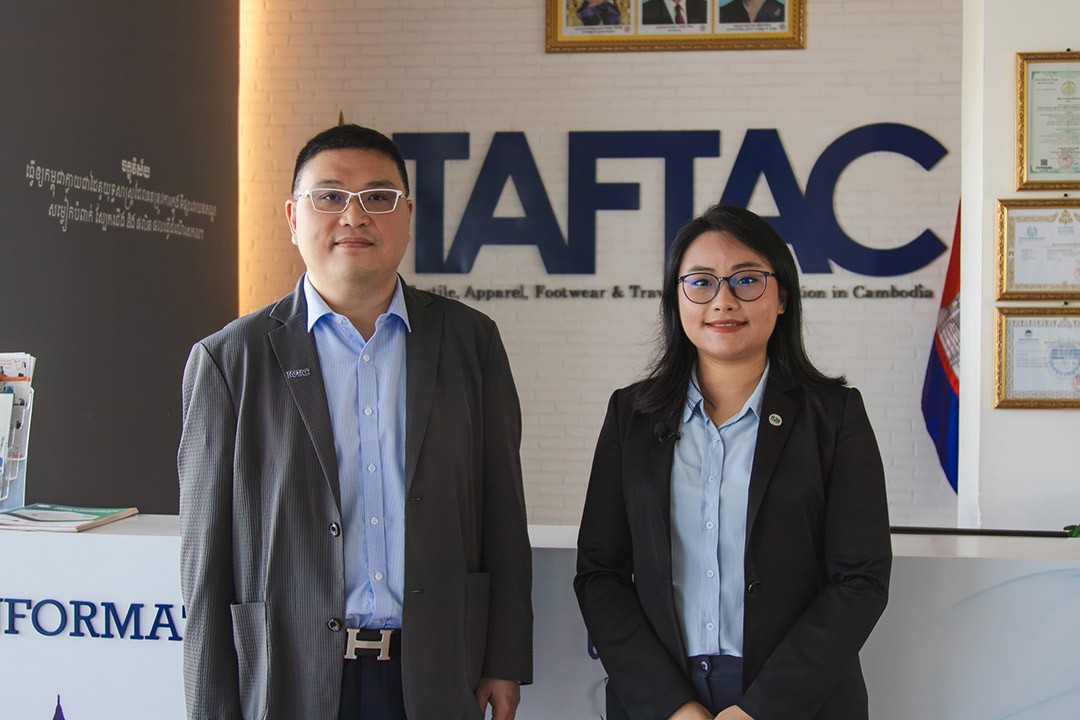
The second episode of B2B Cambodia's 'Industry Update' centres on Cambodia's garment, footwear and travel goods sector with Ken Loo, Secretary General of the Textile, Apparel, Footwear and Travel Goods Association in Cambodia (TAFTAC).
First established in 1996 as the Garment Manufacturers Association in Cambodia (GMAC), the association was renamed to TAFTAC in 2022 to better reflect its expanded scope covering textile, footwear and travel goods.
“At that time (in 1996), there were only garment manufacturers in Cambodia, so naturally, we called ourselves the Garment Manufacturers Association,” explained Loo. “But as time evolved, we had more investors in other sectors, namely in textiles… and certainly, post-2016 we saw a huge expansion of travel goods factories that came to set up shop in Cambodia, so they joined us as members. We also have several footwear factories that are members of the association, so in order to better reflect the makeup of our members, we decided it was time to rename and we did that in 2023.”
As of 2024, membership at TAFTAC stands at about 740, with the association representing approximately 680,000 workers who are currently employed in the sector. As Secretary General of TAFTAC, Loo's main role is to keep the association running, with the main objective of advocating for its members, industry and sector.
“Our main counterparts involve the government and other stakeholders, such as trade unions, international financial institutions, development partners, and NGOs who have an interest in our sector," he added.
Post-Pandemic Recovery Of Cambodia's Textiles, Apparel, Footwear and Travel Goods Sector
“2023 was a difficult year globally for the whole sector, but in 2024 we are seeing some signs of recovery,” started Loo.
He shared that export levels today are actually higher than pre-pandemic levels in 2019, which is a good sign, however, 2023 still proved to be something of a curveball for the industry.
The first half of 2023 looked very good, we thought we were out of COVID and that things were on the rebound, but come 1st July, we fell off a cliff.
“Hopefully 2024 is different, for now it does look different and it looks like the [positive] trend will continue into the second half of the year, and we hope into 2025 and 2026 as well, but we really don't know for sure," Loo added.
In all interviews, I say we are cautiously optimistic, and we need to be so because 2023 was a very, very bad year for investors globally.
Watch Part 2 of the Industry Update on Cambodia's Garment, Footwear And Travel Goods Sector:
What Are The Biggest Challenges TAFTAC Faces In Promoting And Safeguarding Rights Of Its Members?
One of the primary challenges Loo said the association continues to face is the constant pressure to raise wages and provide better benefits to workers, particularly as buyers are not paying more for products.
Times are bad. Buyers are squeezing us, but at the same time, we know that wages only go in one direction, and that's up. It never goes down.
“Even during the COVID years, I think Cambodia was, if not the only one, one of the very, very few that raised the minimum wage during [the pandemic],” he added. “So in the years of 2021 and 2022, where, for the most part, the rest of the world froze wages, we still raised the minimum wage by a little or USD 2 a year.”
Loo noted, however, that there is a growing push globally for more responsible purchasing practices by buyers, whereby they are also increasingly expected to be conscious of their impact on factories, suppliers and workers. Additionally, there is a push by consumers to be more sustainable and to ‘go green’, which Loo affirmed is one of the main focus areas that the association is paying attention to.
Government Policies And Mechanisms That Support Cambodia's Garment Industry
In terms of government support, Loo stated that the Cambodian government has always been quite supportive of the sector, particularly as it accounts for more than 50 per cent of Cambodia's total exports and foreign income.
We are also the largest formal sector employing more than 850,000 workers now, and fortunately for us, the government has always paid high attention to our sector.
Loo highlighted the launch of the Garment Sector Strategy 2022-2027 and Cambodia's new investment law (2021) as two mechanisms that are likely to attract more investors to Cambodia. He also mentioned a number of working groups that allow for private-public dialogue exchange, such as the working group on trade facilitation and export processing – co-chaired by the Minister of Commerce and Neak Oknha Kith Meng – and various others focused on laws, customs, industry and more. Such platforms, Loo stressed, allow TAFTAC members to raise issues for the government to resolve, and he believes they have been quite useful and effective.
The government has been extremely responsive to the needs of our sector, and the association has access to many levels within the government, up to the ministerial or even up to the prime ministerial level. I think this is very rare in other countries, but this certainly exist in Cambodia.